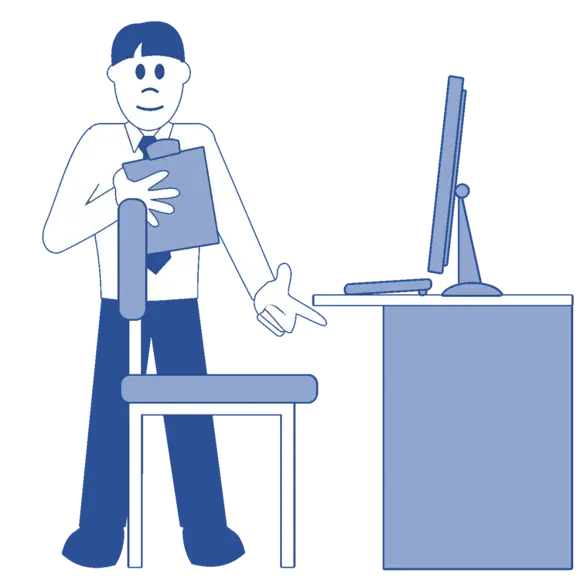Who Do the DSE Regulations Apply To?
These regulations apply to anyone defined as a “DSE user”.
That is, an employee who habitually uses screens for an hour or more daily as part of their normal work. This includes:
Office staff at desks or in control rooms
Remote and hybrid workers
Those using smartphones, tablets, laptops or other portable devices for prolonged tasks
Workers who hot-desk or work from multiple locations
If someone uses a piece of equipment with a screen for long hours, even if they move around, they’re likely covered.
What are employers required to do under the DSE Regulations?
Employers must assess workstations, reduce risks, provide training, and offer eye tests for DSE users. These legal obligations aim to prevent health issues like neck pain, eye strain, and musculoskeletal problems caused by incorrect use of screens over long periods.
The core duties include:
Carrying out workstation assessments
Every DSE user needs their workstation assessed. This includes checking posture, screen position, chair support, lighting, and more.
Reducing identified risks
For example, adjusting screen height to improve posture, providing a footrest, or managing screen glare to reduce headaches.
Planning screen work to include frequent breaks
The law requires that employers limit long periods spent on screens. This means frequent breaks or rotating between screen-based and non-screen tasks.
Providing free eye tests
If an employee requests an eyesight check because of DSE work, the employer must provide one and cover the cost if corrective lenses are needed for DSE use.
Delivering training and information
Every DSE user must be trained on the safe use of screens and workstation setup, how to identify risks like poor posture, and what to do if they experience discomfort or chronic pain.
These duties apply whether the employee is in a formal office or working from home.
Minimum Workstation Requirements (Regulation 3)
Workstations must meet certain basic standards. These aren't optional. They’re part of your legal obligations.
A safe DSE workstation includes:
A screen with clear, stable images and adjustable brightness
A chair with adjustable height and good lumbar support
A keyboard that’s separate from the screen (if using a laptop long-term)
Enough space for legs and freedom of movement
Lighting that avoids screen glare
Low background noise, where possible
These measures help prevent common issues like back pain, eye strain, neck pain, and mental health challenges caused by an uncomfortable or overstimulating environment.
DSE Risk Assessments: What’s Required?
Employers must conduct a risk assessment for each workstation used by a DSE user. This applies to full-time, part-time, hybrid, or remote roles.
When do you need to do an assessment?
When a new user joins
If their setup changes (e.g. a new chair or monitor)
When their working environment changes (e.g., moving to remote work)
If your business has five or more employees, this assessment must be recorded in writing.
For a full guide to DSE risk assessments, see our article: DSE Risk Assessment Guide
Free Download - DSE Risk Assessment Forms
To help you carry out DSE evaluations effectively, we’ve created two free resources: a digital DSE Risk Assessment Form for managers or assessors (printable version) and a digital DSE Workstation Checklist for employee self-assessments (printable version). These templates follow HSE guidance and support good practice across your organisation.
Eye Tests: What the Regulations Require
Employees who use screens are entitled to request an eye and eyesight test, paid for by the employer. If the test shows they need corrective appliances for their work, you may need to contribute to the cost, but only for basic spectacles used specifically for screen work.
This applies across the UK and is enforced by the Health and Safety Executive (HSE).
DSE Training: A Legal Must-Have
The HSE requires all employers to provide training for DSE users. This must include:
How to set up a safe and comfortable workstation
What risks to look out for (e.g. poor posture, long hours, incorrect use of screens)
How to take frequent breaks and vary tasks
What to do if they start to experience issues like carpal tunnel syndrome, back pain, or visual strain
How to report problems
Without this training, your business may be out of compliance with the Health and Safety Display Screen Equipment Regulations 1992.
Final Thoughts
Managing the risks associated with display screens at work is about protecting your people from avoidable harm, whether they’re using DSE equipment in an office or at home, for long or short periods.
Understanding and applying the DSE Regulations is the first step. Regular assessments, proper setup, frequent breaks, and clear training can make a major difference and show your team that their health, comfort, and safety are a priority.
If you're looking for a simple way to meet your training requirements, our Display Screen Equipment Training Course covers everything your employees need to know to stay safe and compliant.



